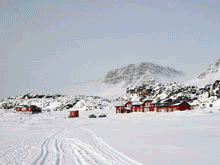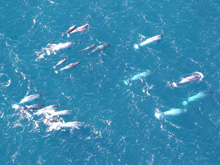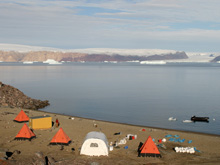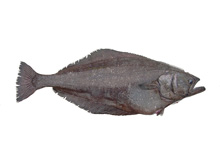The Biology and Ecology of Narwhals
Dr. Kristin Laidre, Polar Science Center
Applied Physics Lab, University of Washington
Dr. Mads Peter Heide-Jørgensen
Greenland Institute of Natural Resources
The narwhal is called Monodon monoceros in the scientific nomenclature, which means “one tooth, one horn”. Narwhals have a black and white mottled skin pattern and are white underneath. This coloration contributed to their name. The old Norse prefix “Nar” means “corpse” and “hval” means “whale”. Thus “corpse whale” refers to how their skin color resembles that of a drowned sailor. The narwhal is an odontocete or toothed whale, but is different from all other toothed whales in that it has no teeth in its mouth. Instead the male develops a long straight tooth (or tusk) that protrudes 2-3 m out of the upper left jaw. The tooth grows in a counterclockwise spiral. The myth of the unicorn comes from the narwhal tusk. Tusks exported from the Arctic, perhaps by the Vikings, reached Europe, the Mediterranean, and even the Far East as early as the Middle Ages. The tusks were sold without a good description of the animal from which they came. Therefore, this unusual spiral appendage inspired a great deal of fantasy. The purpose of having such a huge tooth has been discussed for centuries. Many suggestions have been made. Some believe narwhals use their tusk to dig in the seafloor or spear prey. Others believe the tusk is used for making holes in sea ice or it is used to determine sea ice thickness. Females almost never have a tusk, and the tusk cannot serve a critical function for individuals’ survival, as females live longer than males and occur in the same areas as the males.
It is more likely that male narwhals use the tusk to determine social rank, similar to the antlers of a stag. During the summertime in the northern Canadian high Arctic bays and fjords (long narrow inlets), male narwhals can be seen carefully crossing their tusks as though sword fighting and making a strange, sad whistle. Such behavior might help maintain dominance hierarchies or help young males develop skills necessary for performance in adult sexual roles. Narwhals have not been observed using their tusk for fighting or other aggressive behavior. Male narwhals can reach a length of 5 meters and weigh up to 1,800 kg. Females are somewhat smaller, reaching a length of 4 meters and 1,000 kg. Narwhals reach sexual maturity between 6-9 years, and females give birth to a calf every third year, on average. The gestation period is about 14 months and they give birth in spring (April-May).
Narwhals have predictable migration patterns and are creatures of habit. Even though they spend a large amount of time offshore far from humans, they still move along the coast, and pass certain promontories, bays or fjords at precisely the same time each year. Today, in northwest Greenland, large pods of narwhals arrive every summer and are hunted by Inuit hunters in kayaks with hand-held harpoons.
Narwhal summering grounds in Inglefield Bredning, West Greenland. Narwhals spend the summer in ice-free coastal areas of the high Arctic. They are studied from temporary coastal camps during the summer months when they occupy high Arctic bays and fjords. Scientists live in tent camps like this one (in Northwest Greenland) for approximately one month at a time and catch whales in nets from shore or instrument them offshore from boats. Click image for larger view and image credit.
In summer, narwhals often dive to depths between 30 and 300 meters, although they spend most of their time between 0 and 50 meters. In fall, dive depths and durations increase when narwhals migrate towards their wintering grounds. However, they are traveling rapidly during this period and do not do much focused diving. When narwhals are on their wintering grounds, they stay in a fairly limited area for 6 months and make small movements with the shifting leads and cracks in the pack ice. The proportion of shallow dives dramatically declines, and thus begins some of the deepest diving ever recorded for a marine mammal. Narwhals typically dive to at least 800 meters between 18 and 25 times per day every day for 6 months. Many of these dives go even deeper than 800 meters: over half reach at least 1,500 meters (4,500 feet). Dives to these depths last around 25 minutes, including the time spent at the bottom and the transit down and back from the surface. In addition to making remarkably deep dives, narwhals also spend a large amount of their time below 800 meters (>3 hours per day). This is an incredible amount of time at a depth where the pressure can exceed 2200 PSI (150 atmospheres) and life exists in complete darkness.
One might ask how the narwhal can make such long and deep dives? Narwhals travel to depths where there is intense pressure and no oxygen, which requires special adaptations for survival. The pressure problem is in part solved by having a compressible rib cage which is flexible and can be squeezed as the water depth increases. Narwhals also need mechanisms for bringing along as much oxygen as they can from the surface for their 25 minute long dives. They have a few solutions. Narwhals have a high concentration of myoglobin in their muscles (a molecule which binds oxygen). They have twice as much myoglobin as some seal species and eight times as much as terrestrial mammals, even those specialized in fast running. An average-size narwhal can carry 70 L of oxygen in its lungs, blood, and muscles. This meets oxygen demands for more than 20 minutes underwater at swim speeds of 1 m/s. Furthermore, the narwhal does not have fast-twitch fibers in its skeletal muscles (like a dolphin) but instead has muscles that are suited for endurance swimming (less oxygen demanding). During its dive, a narwhal can save oxygen by shutting off blood flow to selected organs or non-critical body parts. Finally, narwhals have streamlined bodies and can glide easily through the water column towards the bottom. This helps minimize oxygen consumption to work the muscles and ultimately saves energy.
Identifying what narwhals eat has proven to be a difficult task. Narwhals prefer waters far offshore covered in sea ice where they eat at great depths in complete darkness. Because of this, no direct observations of narwhal feeding have ever been made. An alternate method is to examine prey items in the stomachs of dead whales. Narwhals are harvested by local people throughout much of their range and in all seasons, therefore it is possible to collect the entire stomach (sometimes over 35 kg) from narwhals, freeze them, and send them to a laboratory for examination.
Image of a Greenland halibut (Reinhardtius hippoglossoides), the primary winter prey of narwhals. Click image for larger view and image credit.
Hundreds of narwhal stomachs have been examined over the past ten years, and the results have identified interesting patterns. Narwhals eat only a few prey species. Their primary prey include the Greenland halibut, the polar and Arctic cod, shrimp and Gonatus squid. Occasional exceptions have been wolffish, capelin, skate eggs and sometimes rocks, accidentally ingested when whales feed near the bottom. Very few other prey items have been found in narwhal stomachs, implying that narwhals have a very restricted and specialized diet. The size of narwhal prey vary. Greenland halibut eaten by narwhals range from 35-55 cm in length and weigh between 200-1400 grams. Squid eaten by narwhals are much smaller and weigh on average 23 grams.
Narwhals change their diet seasonally. In winter, they feed intensively on Greenland halibut or Gonatus squid. The many deep dives in Baffin Bay and Davis Strait also indicate the narwhals feed intensively on the bottom. The summer ice-free season (between July and September) is not used for intense feeding and whales have very little in their stomachs.
The narwhal’s pattern of intense feeding in winter is the opposite of other sub-arctic whale species. This sheds insight into their specialization necessary for occupying arctic seas. Large baleen whales, such as fin, blue and humpback whales, undertake a northward migration to arctic waters in summer where they feed intensively and obtain their food requirements for the whole year. These species then migrate south for winter and hardly feed at all for the rest of the year. This is when the narwhal arrived on the scene, to feed in winter. The narwhal’s intense winter feeding period is likely an adaptation to relatively low productivity in the high arctic summering areas or perhaps a behavioral trait to avoid competition with lower latitude whales feeding in summer.
Narwhals eat a lot of Greenland halibut in Baffin Bay. This is because the bulk of their energy uptake occurs on the wintering grounds where the narwhals spend more than half of the year. The narwhal’s tendency to return to the same wintering grounds year after year (high site fidelity) has provided an opportunity to compare food consumption in different areas.
The removal of such large quantities of Greenland halibut is very focused in a small area on the sea floor. Narwhals must make perpendicular dives to reach the bottom in order to have enough time to find and eat halibut before returning to the surface for air. This focused removal of fish at special localities can be seen through differences in the number of Greenland halibut in narwhal wintering areas and the length frequency distributions of the fish in different areas.
References:
Finley, K. J., and E. J. Gibb. 1982. Summer diet of the narwhal (Monodon monoceros) in Pond Inlet, northern Baffin Island. Canadian Journal of Zoology 60:3353-3363.
Heide-Jørgensen, M. P. and K. L. Laidre. 2006. ”Greenland’s Winter Whales: the beluga, the narwhal and the bowhead whale”. Published in Danish as ”Grønlands Vinterhvaler: Hvidhvalen, narhvalen og grønlandshvalen” and in Greenlandic as ”Kalaallit Nunaanni ukiumi arferit: Qilalugaq qaqortaq, qilalugaq qernertaq arfivillu”. Ilinniusiorfik Undervisningsmiddelforlag, Nuuk, Greenland. 128 pages.ISBN-13: 978-87-7975-300-6.
Heide-Jørgensen, M. P., and R. Dietz. 1995. Some characteristics of narwhal, Monodonmonoceros, diving behaviour in Baffin Bay. Canadian Journal of Zoology 73: 2120-2132.
Laidre, K. L., and Heide-Jørgensen, M. P.. 2005. Winter feeding intensity of narwhals. Marine Mammal Science 21(1): 45-57.
Laidre, K. L., M. P. Heide-Jørgensen, O. A. Jørgensen, and M. A. Treble. 2004. Deep ocean predation by a high Arctic cetacean. ICES Journal of Marine Science 61(3): 430-440.
Laidre, K. L., M. P. Heide-Jørgensen, R. Dietz, R. C. Hobbs, and O. A. Jørgensen. 2003. Deep-diving by narwhals, Monodon monoceros: differences in foraging behavior between wintering areas? Marine Ecology Progress Series 261:269-281.


















